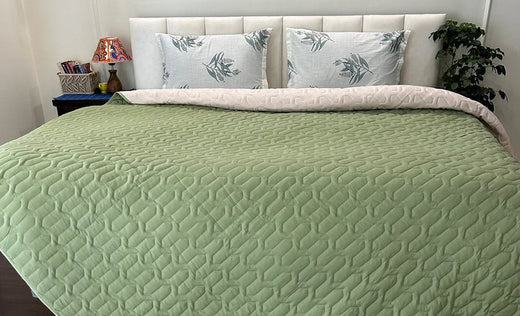Understanding GSM in Fabric: A Comprehensive Guide to Fabric Weight & Comfort

Fabric weight is a crucial aspect of textiles that affects their feel, functionality, and suitability for specific purposes. One of the most common metrics for determining fabric weight is GSM, or grams per square meter. In this comprehensive guide, we’ll explore the concept of GSM, its relevance in fabrics like blankets, and how it influences the comfort, durability, and practicality of textiles.
1. What is GSM in Fabric?
GSM stands for grams per square meter, a measure of the weight of a fabric over a specific area. It provides a standardized way to compare different textiles based on their density and weight.
-
Higher GSM: Indicates a denser, heavier fabric, often associated with warmth, durability, and less breathability.
-
Lower GSM: Denotes a lighter, more breathable fabric, ideal for warmer climates or layering.
2. GSM Ranges and Their Applications
Understanding the GSM range of a fabric helps in choosing the right material for your needs:
| GSM Range Fabric Type | Typical Uses |
|---|---|
| 50–100 GSM Lightweight fabrics | Summer clothing, curtains, light scarves |
| 100–200 GSM Medium-weight fabrics | Shirts, t-shirts, lightweight bed linens |
| 200–300 GSM Heavier medium-weight | Sweatshirts, casual pants, moderate blankets |
| 300+ GSM Heavy fabrics | Winter coats, thick blankets, upholstery |
3. GSM in Blankets
Blankets are a quintessential home textile where GSM plays a pivotal role in determining comfort, warmth, and usability. The GSM of a blanket directly influences its suitability for different seasons and personal preferences.
3.1 Common GSM Ranges for Blankets
-
150–200 GSM: Lightweight, suitable for summers or layering.
-
200–300 GSM: Mid-weight blankets, great for moderate climates.
-
300–500 GSM: Heavyweight blankets, ideal for winters and colder regions.
3.2 Popular Blanket Types by GSM
-
Fleece Blankets (200–300 GSM): Soft and lightweight, perfect for moderate warmth.
-
Wool Blankets (400+ GSM): Dense and insulating, offering superior warmth.
-
Cotton Blankets (250–350 GSM): Breathable yet substantial, suitable for year-round use.
-
Weighted Blankets (300–500 GSM): High GSM due to added fillings, designed for therapeutic purposes.
4. Factors Influencing Fabric GSM
Several factors determine the GSM of a fabric:
4.1 Fiber Content
-
Natural fibers like cotton and wool often have a higher GSM compared to synthetic materials like polyester or nylon due to their inherent density.
4.2 Weaving or Knitting Technique
-
Tightly woven fabrics: Higher GSM, more durable, and less breathable.
-
Loosely woven fabrics: Lower GSM, softer, and more breathable.
4.3 Finishing Techniques
-
Fabric treatments like brushing, napping, or adding fillers can significantly increase the perceived GSM and improve comfort.
5. GSM and Comfort
Comfort in textiles often depends on the right balance between GSM, breathability, and fabric texture.
5.1 Seasonal Suitability
-
Low GSM fabrics: Lightweight and breathable, ideal for hot weather.
-
High GSM fabrics: Heavy and insulating, suitable for cold climates.
5.2 Skin Sensitivity
-
Fabrics with a high GSM can sometimes feel stiff or less pliable. Choosing materials like brushed cotton or fleece can mitigate this.
5.3 Weight vs. Warmth
-
A higher GSM doesn’t always guarantee better insulation. Factors like fiber type and weave also contribute to warmth.
6. How to Measure GSM?
GSM can be measured at home or in a laboratory setting:
6.1 DIY GSM Calculation
-
Cut a square of fabric measuring 10 cm x 10 cm (or 0.01 m²).
-
Weigh the fabric square in grams using a precise scale.
-
Multiply the weight by 100 to calculate the GSM.
-
For example, if the 10 cm x 10 cm square weighs 3 grams, the GSM is 300.
6.2 Laboratory Measurement
-
Professional fabric testing involves using specialized equipment for precise GSM calculations, ensuring consistency across batches.
7. GSM and Environmental Impact
The environmental footprint of a fabric is also linked to its GSM, as heavier fabrics require more raw materials and energy to produce.
7.1 Low GSM Fabrics
-
Generally require fewer resources to produce.
-
Often more suitable for disposable or fast-fashion applications.
7.2 High GSM Fabrics
-
Tend to last longer, reducing the need for frequent replacements.
-
Often used in sustainable fashion and home textiles for durability.
8. Choosing the Right GSM for Your Needs
Selecting the right GSM involves considering various factors:
8.1 For Clothing
-
Summer: Lightweight fabrics (100–150 GSM).
-
Winter: Heavier fabrics (200+ GSM).
8.2 For Home Textiles
-
Curtains: 150–250 GSM for light filtering; 300+ GSM for blackout curtains.
-
Bed Sheets: 150–300 GSM, depending on seasonal needs.
-
Blankets: Choose based on the climate and desired warmth.
9. Common Myths About GSM
-
Myth 1: Higher GSM Always Equals Higher Quality
While GSM indicates weight, it doesn’t necessarily correlate with quality. Fiber type and manufacturing techniques also play crucial roles.
-
Myth 2: GSM Is the Only Factor in Comfort
Comfort also depends on texture, breathability, and fabric structure.
-
Myth 3: High GSM Fabrics Are Always Durable
Durability depends on the quality of the fibers and how the fabric is woven or knitted.
10. Modern Trends in GSM and Fabric Weight
The fabric industry is evolving, with innovations focusing on achieving optimal GSM for various purposes:
-
Lightweight Fabrics with High Performance
New materials like microfibers and technical textiles offer low GSM with high strength and functionality.
-
Sustainable High GSM Fabrics
Recycled and organic fibers are being used to create dense, durable fabrics with minimal environmental impact.
Conclusion
Understanding GSM is fundamental when selecting fabrics for clothing, home textiles, or specialized uses like blankets. By recognizing the relationship between fabric weight, comfort, and functionality, you can make informed decisions tailored to your needs. Whether you’re looking for a cozy winter blanket or lightweight summer curtains, GSM is a key metric to guide your choice.
